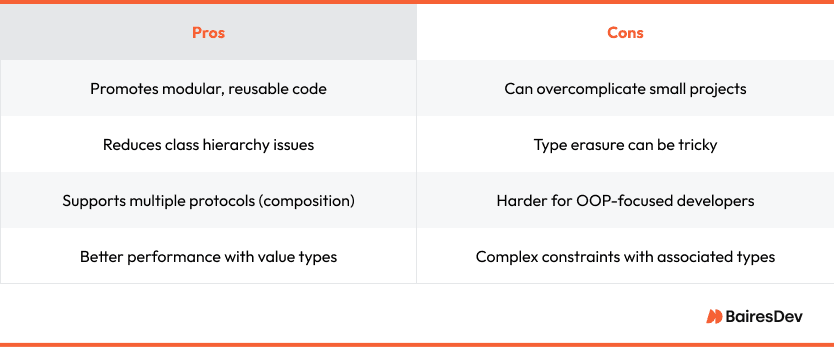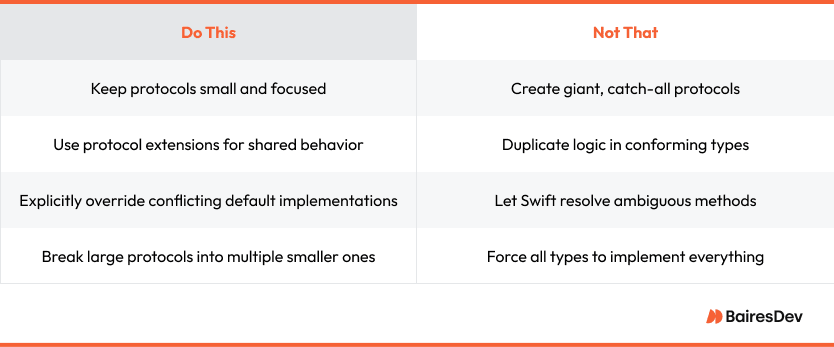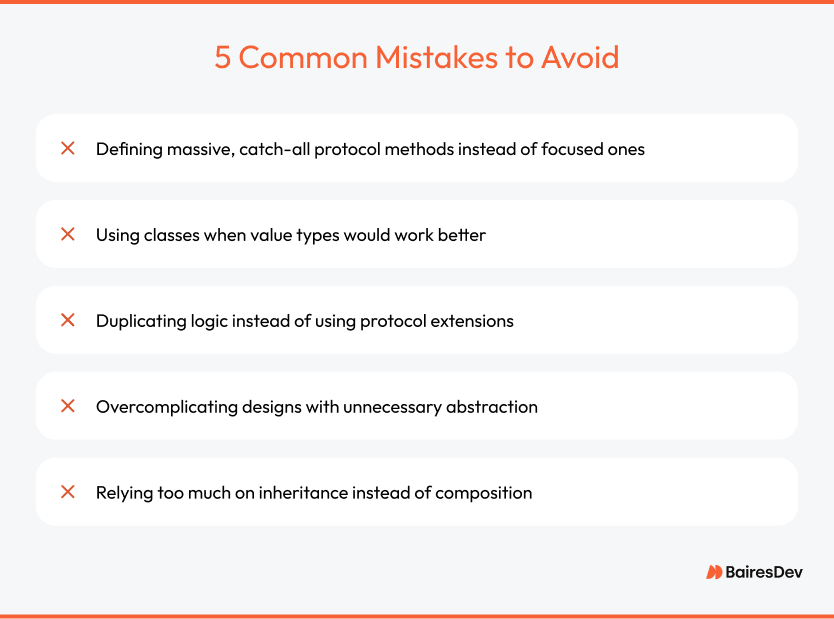If you’re knee-deep in subclass spaghetti, Swift’s protocol-oriented programming (POP) can clean up the mess. But is it the code refactoring ammo most programmers say it is? Or just OOP in disguise?
If you don’t get it when Swift developers rave about POP vs. OOP, you’re not alone. Let’s look at what makes protocol-oriented programming so powerful. We’ll clear the misconceptions and show you how POP cuts down on boilerplate and injects default behavior across multiple types.
Your code will be cleaner and easier to test. This is why many a Swift app development company has embraced this paradigm for their client projects. As Crusty put it, “Protocol extensions let you focus on what your types do, not what they are.”
What is Swift Protocol-Oriented Programming?
Swift Protocol-Oriented Programming (POP) is a paradigm that emphasizes building functionality with protocols and extensions. It shifts focus from class hierarchies to behavior reuse through protocol composition and default implementations. The result is code that’s both modular and testable.
In POP:
- Protocols define behavior requirements.
- Protocol extensions provide shared implementations.
- Value types handle state management.
Unlike traditional object-oriented programming, which relies on class inheritance, POP promotes composition and avoids rigid hierarchies. It’s often more flexible and modular than OOP.
POP vs. OOP Quick Comparison:
| Feature | Protocol-Oriented Programming (POP) | Object-Oriented Programming (OOP) |
| Core Concept | Behavior-focused, using protocols and extensions | Structure-focused, using classes and inheritance |
| Code Reuse | Through protocol extensions and default implementations | Through class inheritance and method overriding |
| Flexibility | High—supports multiple protocols (composition) | Limited—relies on single inheritance and abstract classes |
| Type Usage | Primarily value types (structs, enums) | Primarily reference types (classes) |
| Inheritance | No inheritance; behaviors combined through protocol composition | Class-based, supporting single or multiple inheritance (some languages) |
| Performance | Faster, especially with value types (avoids reference overhead) | Slower, due to reference counting and object lifecycle management |
| Modularity | High—protocols can define isolated capabilities | Lower—deep hierarchies can lead to tightly coupled code |
| Swift Example | protocol Drawable { func draw() } with extension Drawable providing defaults | class Shape { func draw() { } } with subclasses like Circle, Square |
| Multiple Behavior Support | Supports multiple protocols in a single type | Requires multiple inheritance or interfaces (if available) |
Dart Mixins vs. Swift POP
Swift protocol extensions support shared behavior for both value and reference types. Dart mixins primarily work within class hierarchies without Swift’s value-type advantages.
Why Use Protocol-Oriented Programming in Swift?
You’re squinting at Xcode on your ultra-wide monitor, sifting through a tangled mess of subclasses and overrides. One tiny change breaks everything. Frustrating, right? Swift’s protocol-oriented programming cuts through the chaos by focusing on behavior composition instead of class hierarchies. You can use protocol extensions to inject shared functionality across multiple types without duplicating code. You’ll slash inheritance headaches and keep your codebase lean and modular.
In POP, protocols define behavior contracts, while default implementations in extensions let you reuse logic without forcing a class hierarchy. Unlike object-oriented programming languages, POP’s composition makes your code more flexible and easier to test.
Pros and Cons of POP:

Real-World Example:
In a game, you have characters that can jump and attack.
- With OOP: You’d create a Character base class with subclasses like Warrior and Mage. Over time, this leads to class bloat.
- With POP: You’d create Jumpable and Attackable protocols. Characters adopt multiple protocols to gain abilities, keeping behaviors modular and reusable.
Core Concepts of Protocol-Oriented Programming
If you don’t know Swift’s core POP concepts, you can waste hours wrestling with duplicated code. Let’s cover the top three:
- Protocols and Extensions: Swift’s protocol-oriented programming uses protocols to define behavior. Its protocol extensions add reusable logic. You can use default implementations to share functionality across multiple types without inheritance. That makes your code modular and clean.
- Protocol Composition: Rather than forcing deep class hierarchies, POP encourages combining behaviors via multiple protocols. For example, a Flyable and Swimmable protocol can be composed into an Amphibious type. This offers flexibility without the downsides of traditional inheritance.
- Value vs. Reference Types: Swift’s POP prioritizes value types, like structs, over classes for safer, more predictable behavior. Value types are copied when assigned. This prevents shared-state bugs—which is essential to eliminate for thread-safe, scalable apps.
POP vs. OOP: When to Use Each Approach
If you’re scratching your head over when to use OOP or POP, here’s a quick decision matrix:
- Use POP for modular, reusable components and behavior-driven design. It’s great for apps that need composable features like feeds or filters.
- Choose OOP for class-based hierarchies, like complex UI components with shared properties and behaviors.
Social Media Feed Example:
With POP, define Likeable, Commentable, and Shareable protocol methods. Then, combine them for different post types—VideoPost, PhotoPost, ArticlePost—to promote reuse without inheritance.
POP Approach (Composable, Modular):
protocol Likeable {
func like()
}
protocol Commentable {
func comment(_ text: String)
}
protocol Shareable {
func share()
}
// Combine behaviors using protocol composition
struct VideoPost: Likeable, Commentable, Shareable {
func like() { print("Liked the video!") }
func comment(_ text: String) { print("Commented on video: \(text)") }
func share() { print("Shared the video!") }
}
struct PhotoPost: Likeable, Shareable {
func like() { print("Liked the photo!") }
func share() { print("Shared the photo!") }
}
let video = VideoPost()
video.like()
video.comment("Awesome clip!")
video.share()
With OOP, you’d create a Post base class and subclass it for each type. But this approach gets rigid fast, with shared logic scattered across subclasses.
OOP Approach (Inheritance-Based):
class Post {
func like() { print("Liked the post!") }
func share() { print("Shared the post!") }
}
class VideoPost: Post {
func comment(_ text: String) { print("Commented on video: \(text)") }
}
class PhotoPost: Post {}
let video = VideoPost()
video.like()
video.comment("Great video!")
video.share()
Building a Protocol-Oriented Swift App (Step-by-Step Tutorial)
There’s a really good reason so many programmers like Swift POP. Its reusable code structures make it work like Mjolnir. Let’s walk through building a Swift app using POP principles.
Step 1: Define Protocols for App Features
Like Rob Napier says, “Start with a protocol.” Here’s how to do one for Swift POP.
protocol Trackable {
func trackEvent(name: String)
}
protocol Sharable {
func share(content: String)
}
Step 2: Implement Default Behaviors via Extensions
Use protocol extensions to add shared behavior without rewriting code.
extension Trackable {
func trackEvent(name: String) {
print("Tracking event: \(name)")
}
}
extension Sharable {
func share(content: String) {
print("Sharing: \(content)")
}
}
Step 3: Create Structs that Conform to Protocols
Structs use default implementations from extensions to save time.
struct Article: Trackable, Sharable {}
struct Video: Trackable {}
let article = Article()
article.trackEvent(name: "Article Viewed")
article.share(content: "Check out this article!")
Step 4: Reuse Components with Composition
Compose multiple features without deep hierarchies, using protocol composition instead of rigid class inheritance. There’s no need to support multiple inheritance.
struct SocialPost: Trackable, Sharable {}
let post = SocialPost()
post.trackEvent(name: "Post Liked")
post.share(content: "New post alert!")
Common POP Pitfalls and How to Fix Them
James, a Swift developer, writes modular, scalable code effortlessly. His secret? He dodges common protocol oriented programming language pitfalls like Chris Lattner. Here’s how you can, too.
Default Drama: Resolve Conflicting Implementations
When two protocol extensions give conflicting default implementations, Swift doesn’t know which to use. The fix? Override the method explicitly in the conforming type.
protocol A { func greet() }
extension A { func greet() { print("Hello from A") } }
protocol B { func greet() }
extension B { func greet() { print("Hello from B") } }
struct MyStruct: A, B {
func greet() { print("Explicit choice!") }
}
Mixin Madness: Keep Protocols Single-Purpose
Overloading a protocol with unrelated protocol methods creates bloated, hard-to-maintain code. Keep protocols focused on one responsibility.
Conformance Crisis: Split Large Protocols
If a protocol forces types to implement too much, break it into extending protocols that define smaller, more manageable units.
Do This, Not That: Common POP Pitfalls

Best Practices for Swift Protocol-Oriented Programming
Picture this: You’re debugging a nightmare—massive protocols, bloated classes, and unpredictable behavior. If only you had followed protocol-oriented programming best practices. Here’s how to get it right.
Use Focused, Single-Responsibility Protocols
A protocol should define one clear role. Avoid bloated protocols that force unrelated behaviors. Breaking them into smaller protocol models abstraction keeps your code modular and maintainable.
Prefer Value Types for Performance and Safety
Use value types like structs to prevent unintended side effects and improve performance by avoiding unnecessary reference copying. Choose structs over classes whenever possible.
Leverage Extensions for Reusable Logic
Use protocol extensions to provide default implementations that multiple types can adopt. You’ll cut down on duplication and keep your codebase lean. Extending protocols let you add new behaviors without modifying existing code.
protocol Loggable { func logMessage() } extension Loggable { func logMessage() { print("Logging event") } }
Master POP, Master Swift
POP isn’t a buzzword. It works because protocols define clear contracts for behavior. Combined with OOP, it lets you create maintainable code that’s modular and testable. Mastering it may not put you up there with Holly Borla overnight, but it’ll clean up your code considerably.
As protocol extensions simplify reuse, your Swift skills will evolve beyond basic class hierarchies. You’ll start architecting scalable, efficient apps. Like Crusty says, “Focus on what your types do, not what they are.”







